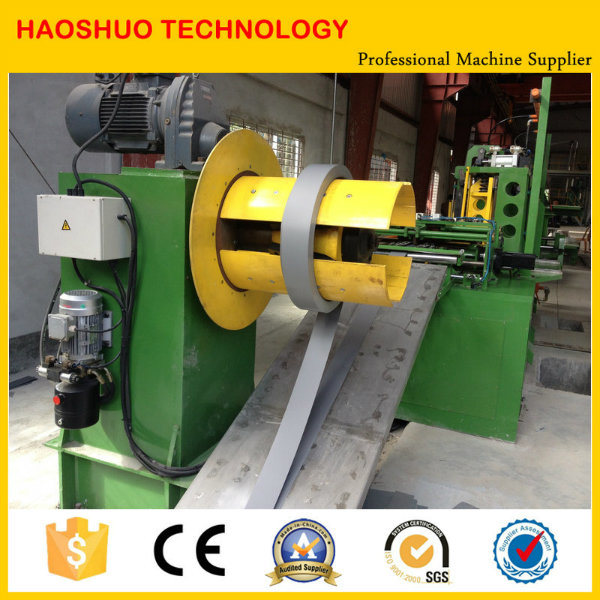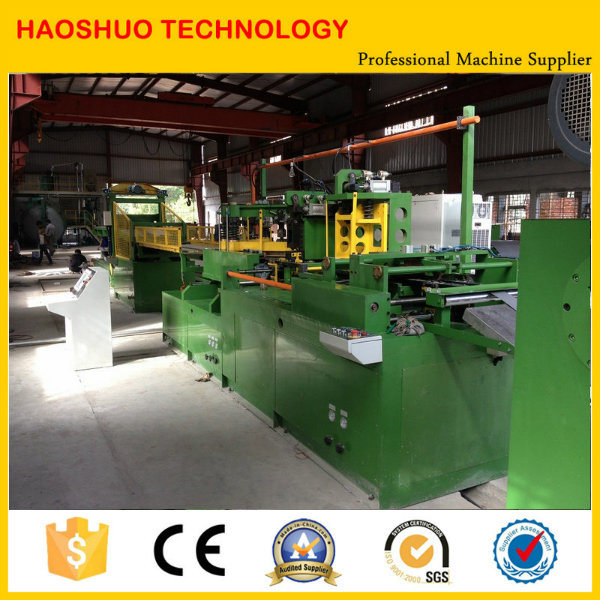High Speed Transformer Step-Lap Core Cut to Length Line
This production line is automatic cut to length line for silicon steel coil, is necessary production equipment for transformer lamination manufacturing. It can cut 45 degree and 135 degree shear, transverse and longitudinal progressive shear, hole punching and v notching. The line can be suitable for cutting series shapes of work pieces used in the manufacturing of transformer industry.
Our production line has high quality with high speed. All electric elements use International famous brand products. The line has high stable performance with high precision.
Work Process:
Coil decoiling -- buffer plate for coil storage -- servo feeding for length measuring -- electric hole punching -- servo positioning -- servo V notching -- cutting coil sheet into required shapes by 2 shearers -- work pieces feeding & collecting -- automatic product stacking
Main Technical Data
| Item | Parameter |
| Cutting width | 40-440mm, 60-660mm |
| Cutting thickness | 0.23-0.35mm |
| Max coil weight | 1000kg, 2000kg |
| Cutting piece length | 320-2500mm, 400-3500mm |
| Max feeding speed | 240m/min |
| Length accuracy | ± 0.2mm |
| Cutting burr | ≤ 0.02mm |
| Cutting angle precision | ± 0.025 degree |



Textile chemicals are Agricultural Grade Phosphate and Tech Grade Phosphate used in the textile industry to enhance the quality, performance, and appearance of textiles. These chemicals are used at various stages of textile production, including fiber production, dyeing, printing, finishing, and laundering.
Some common types of textile chemicals include:
1. Dyes and pigments: These chemicals are used to add color to textiles. They can be either natural or synthetic and are available in a wide range of colors.
2. Auxiliaries: These chemicals are used to improve the dyeing and printing process. They can help to enhance color fastness, improve dye penetration, and prevent bleeding of colors.
3. Finishing chemicals: These chemicals are used to improve the properties of textiles, such as softness, wrinkle resistance, water repellency, and flame retardancy. Some common finishing chemicals include fabric softeners, anti-static agents, and water repellents.
4. Bleaching agents: These chemicals are used to remove impurities and whiten textiles. They are commonly used in the production of white or light-colored fabrics.
5. Surfactants: These chemicals are used as wetting agents, emulsifiers, and detergents in textile processing. They help to improve the penetration of dyes and other chemicals into the fabric.
6. Flame retardants: These chemicals are used to make textiles resistant to fire. They are commonly used in the production of protective clothing and home furnishing fabrics
7. Antimicrobial agents: These chemicals are used to prevent the growth of bacteria, fungi, and other microorganisms on textiles. They are commonly used in the production of medical textiles and sportswear.
It is important to note that the use of textile chemicals is regulated by various environmental and health regulations to ensure their safe use and minimize their impact on the environment and human health.
general grade products Soybean Wax, Eco-Wax 100% Organic Soy Wax, Soybean Wax Paraffin Candle
Sichuan Jinhe Qihang Co,. Ltd. , https://www.jqfoodadditives.com